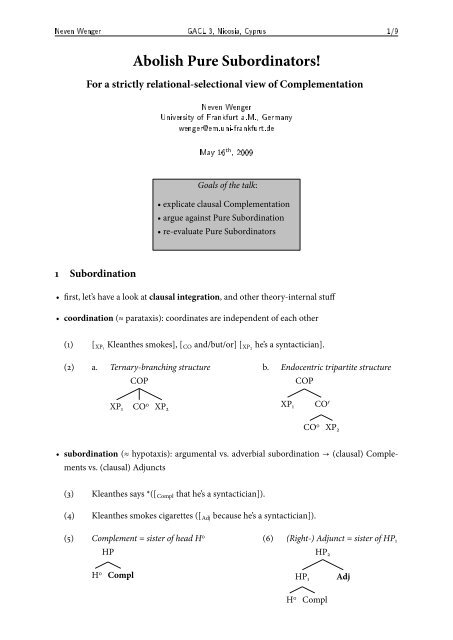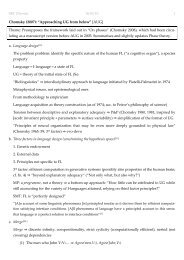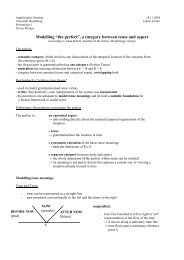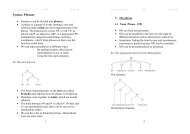Abolish Pure Subordinators! - satzstrukturen
Abolish Pure Subordinators! - satzstrukturen
Abolish Pure Subordinators! - satzstrukturen
You also want an ePaper? Increase the reach of your titles
YUMPU automatically turns print PDFs into web optimized ePapers that Google loves.
����� ������ ���� �� �������� ������ ���<br />
<strong>Abolish</strong> <strong>Pure</strong> <strong>Subordinators</strong>!<br />
For a strictly relational-selectional view of Complementation<br />
1 Subordination<br />
����� ������<br />
���������� �� ��������� ����� �������<br />
��������������������������<br />
��� �� th � ����<br />
Goals of the talk:<br />
• explicate clausal Complementation<br />
• argue against <strong>Pure</strong> Subordination<br />
• re-evaluate <strong>Pure</strong> <strong>Subordinators</strong><br />
• first, let’s have a look at clausal integration, and other theory-internal stuff<br />
• coordination (≈ parataxis): coordinates are independent of each other<br />
(1) [XP1 Kleanthes smokes], [CO and/but/or] [XP2 he’s a syntactician].<br />
(2) a. Ternary-branching structure<br />
COP<br />
XP1 CO 0 XP2<br />
b. Endocentric tripartite structure<br />
XP1<br />
COP<br />
CO ′<br />
CO 0 XP2<br />
• subordination (≈ hypotaxis): argumental vs. adverbial subordination → (clausal) Comple-<br />
ments vs. (clausal) Adjuncts<br />
(3) Kleanthes says *([Compl that he’s a syntactician]).<br />
(4) Kleanthes smokes cigarettes ([Adj because he’s a syntactician]).<br />
(5) Complement = sister of head H 0<br />
HP<br />
H 0 Compl<br />
(6) (Right-) Adjunct = sister of HP1<br />
HP1<br />
HP2<br />
H 0 Compl<br />
Adj
����� ������ ���� �� �������� ������ ���<br />
• both Compls and Adjs are dependent structures (i.e. they can’t stand on their own):<br />
(7) a. *That he’s a syntactician.<br />
b. *Because he’s a syntactician.<br />
• but: omission of Adjs leaves the remaining matrix clause intact, omission of Compls not:<br />
(8) a. *Kleanthes says that he’s a syntactician.<br />
b. Kleanthes smokes cigarettes because he’s a syntactician.<br />
• Compls are tightly integrated into complex sentential structures, while Adjs are less so (5)/(6)<br />
(semantically, argumental Compls saturate V → obligatory)<br />
• Complementation as c-selection (subcategorisarion): a lexical head L 0 selects for a functional<br />
head F 0 /feature [uF] → selection as Sister-Merge, Merge as agree (cf. Boeckx, 2008): a probe<br />
[uF] on L 0 searches for the closest matching goal [F] on F 0 ( L[uF]...F[F] → L[uF]...F[F] )<br />
(9) L 0 selects for FP<br />
LP<br />
L 0<br />
[uF]<br />
FP<br />
[F]<br />
(10) V 0 selects for CP<br />
VP<br />
V 0<br />
[uC]<br />
thinks<br />
CP<br />
[C]<br />
[that...]<br />
Q: What is the nature of [F]? Is it a subordination feature [sub] contained in F 0 (typically<br />
C 0 ) targeted by [uF], thereby establishing a subordinate dependency? Or is [F] really a cat-<br />
egorial feature ([C], [I], [v] or [Force], [Fin], etc.), subordination being an epiphenomenal<br />
– configurational – dependency (as with θ-roles given the UTAH)?<br />
(11) Configurational<br />
CP<br />
C 0<br />
[decl]<br />
that<br />
IP<br />
he smokes<br />
(12) Featural<br />
CP<br />
C 0<br />
? [sub]<br />
[decl]<br />
that<br />
IP<br />
he smokes<br />
Proposal: along minimalist guidelines, the configurational (= phrase-structural) contrast<br />
between Compls and Adjs given in (5)/(6) above should suffice to interpret Complemen-<br />
tation configurationally rather than featurally.
����� ������ ���� �� �������� ������ ���<br />
(13) clausal complementation<br />
A clausal Complement is the sister FP of L 0 (= V 0 ). The configuration [LP L 0 FP ] is<br />
established by agree(L,F) (= c-selection), where the probe [uF] on L 0 agrees with the<br />
matching feature [F] heading its Merge-partner FP.<br />
• L 0 can c-select for Compls headed by variable types of F 0 , corresponding to different se-<br />
mantic entities: v 0 = event, Asp 0 = situation/interval, Fin 0 = proposition, C 0 = ut-<br />
terance/speech act → different partitions of syntactic structure correspond to different<br />
semantic entities (cf. e.g. Svenonius 2008:67ff.)<br />
(14) see[uForce] – see[uAsp]<br />
a. I saw [ForceP that Kleanthes smoked a cigarette]. (But actually it was a cigar...)<br />
b. I saw [AspP Kleanthes smoke a cigarette]. (#But actually it was a cigar...)<br />
But: Despite conceptual issues, there is empirical (= positional) evidence for <strong>Pure</strong> Subor-<br />
dinators...<br />
2 <strong>Pure</strong> subordinators<br />
background...<br />
• <strong>Pure</strong> <strong>Subordinators</strong> (Subs) revive the traditional view of the function of COMPs (also cf.<br />
Hockett 1958: 194, Matthews 1981: 192, Quirk et al. 1985: 997): “lexical complementizers in<br />
languages like English also function as markers of subordination [emphasis mine], wherefore<br />
the traditional designation is ‘subordinating conjunction” (Bhatt 1999:152)<br />
• cartographies: CFCs (‘macro-categories’: C 0 , I 0 , v 0 ) are really more fine-grained sequences<br />
(C 0 = Force 0 > Fin 0 ; cf. Rizzi 1997 et seq.) → motivation: (i) functionally different COMPs<br />
(Force-typers, finiteness-markers), (ii) multiple COMPs, (iii) position of COMPs w.r.t. dis-<br />
course-fronted elements (topic, focus, etc.)<br />
• root/embedded asymmetry (cf. e.g. Bayer 2004): [sub] is sometimes considered a feature<br />
contained in embedded C 0 alongside [force, fin, top/foc, etc.] → in certain languages, under<br />
certain circumstances, [sub] seems to project independently as the highest head in the C-<br />
domain (an option considered in Rizzi 1997: 328, fn. 6, citing Bhatt & Yoon 1992: Sub 0 > Force 0<br />
> Fin 0 )<br />
• analytic vs. synthetic patterns (cf. Fortuny 2008): features may be lexicalised synthetically<br />
(a.k.a. syncretically), as one unsplit head, or analytically, with some (not necessarily all, but<br />
keeping with hierarchical ordering restrictions) feature(s) projecting independently (cf. Giorgi<br />
& Pianesi’s 1997:15 feature scattering, Fortuny’s 2008:62 feature spreading) → the reason for an-<br />
alytic patterning aren’t clear, though...(simply parametric variation?)
����� ������ ���� �� �������� ������ ���<br />
(15) Synthetic C 0<br />
C 0<br />
[sub]<br />
[force]<br />
[fin]<br />
CP<br />
IP<br />
...<br />
(16) Analytic C 0<br />
SubP<br />
Sub 0 CP<br />
C 0<br />
[sub]<br />
[force]<br />
[fin]<br />
IP<br />
...<br />
(17) Max. Analytic C 0<br />
SubP<br />
Sub 0 ForceP<br />
Force 0 FinP<br />
Rule of thumb: Since e.g. for selectional reasons (cf. 3) the highest head in the C-domain is<br />
generally considered to be related to Sentential Force (a.k.a. Sentence Mood, Clause Type)<br />
– think selects for a declarative Complement, ask for an interrogative one –, any<br />
element intervening between V 0 and the Force-marker needs to be accounted for – e.g. in<br />
terms of <strong>Pure</strong> <strong>Subordinators</strong><br />
[VP V 0 [Compl X 0 [Force 0 ...] ] ]<br />
2.1 Kashmiri (Bhatt & Yoon 1992, Bhatt 1999)<br />
Fin 0 IP<br />
• Bhatt & Yoon (1992), an early precursor to Rizzi’s (1997) et seq. split-CP hypothesis, propose<br />
Sub 0 for Kashmiri (as well as Korean and Japanese) 1<br />
• Kashmiri is a symmetrical V2-language: V2 (= V-to-C movement) also holds in embedded<br />
clauses introduced by a COMP (≠ e.g. German)<br />
(18) a. Gestern rauchteV2 Kleanthes wenig Zigaretten.<br />
yesterday smoked Kleanthes few cigarettes<br />
b. Ich<br />
I<br />
glaube,<br />
think<br />
dassC<br />
that<br />
gestern Kleanthes wenig Zigaretten rauchte.<br />
yesterday Kleanthes few cigarettes smoked<br />
(19) a. raath khyavV2 tem batI (Bhatt 1999:47)<br />
yesterday ate he food<br />
b. me<br />
I<br />
buuz [kiC raath vuchV2 rameshan shiila] (Bhatt 1999:98)<br />
heard that yesterday saw Ramesh Sheila<br />
• parametric theory of V2: (i) universal requirement for overt clause-typing (cf. Weerman<br />
1989, Cheng 1991), be it verbal (e.g. V2), or non-verbal (e.g. dass ‘that’); (ii) COMP consists of<br />
[force] and [sub], paramterically either lexicalised synthetically or analytically<br />
1 In their system, Sub 0 is adjoined to M(ood) 0 (= Rizzi’s 1997 Force 0 ) instead of projecting independently, which<br />
is problematic given the ban on maximal Head Adjunction qua the Uniformity Condition (cf. Chomsky 1994:406).<br />
Like others, I reinterpret Sub 0 as an independently projecting feature.<br />
...
����� ������ ���� �� �������� ������ ���<br />
• Kashmiri seems to realise [sub] separately from Force-markers → it can have COMP + V2<br />
(19-b), and marks Mood independently of subordinators<br />
(20) a. tem dop ki su gatshi-hee (from Bhatt & Yoon 1992:50)<br />
he said that he go-subj<br />
‘He said that he would go.’<br />
b. tem prutsh ki su gatshy-aa<br />
he asked that he go-int<br />
‘He asked if he goes.’<br />
• problem: Bhatt & Yoon make no distinction between Verb Mood (VM) and Sentence Mood<br />
(p. 43: “a category that indicates clause-type, or Mood”; p. 47 “Mood is verbal”) – they assume<br />
that both V (V-to-C/V2 or affixal Verbal Mood) and ‘particles’ (= COMPs) may satisfy the<br />
clause-typing condition in Force 0 (their M 0 ) → by this reasoning, anytime an overt VM in-<br />
flection co-occurs with what looks like a COMP, one must assume that the COMP is a mere<br />
Sub<br />
But: even though there is indeed a strong dependency between Force and VM (the C-Infl<br />
link in Fortuny’s 2008 terms), it isn’t desireable to simply conflate these two categories into<br />
one – if not for the fact that e.g. indicative (or: default VM) can co-occur with (at least)<br />
two clause types declaratives and interrogatives!<br />
2.2 Modern Greek (Roussou 2000)<br />
• Roussou 2000 reanalyses the Greek C-<br />
domain based on Rizzi’s (1997) system, ex-<br />
panding it by another projection dominat-<br />
ing Force 0 : Sub 02<br />
(21) SubP<br />
Sub 0 ForceP<br />
Force 0 FinP<br />
Fin 0 IP<br />
• based on the distribution of C-related par-<br />
ticles: Subordinator pu, Force-COMPs oti<br />
(decl) and an (int), Force-indicator as (im-<br />
per), negators den and min, modal particles<br />
na (subj) and tha (fut) (cf. pp. 65, 79)<br />
(22) SubP<br />
Sub 0<br />
pu<br />
(oti)<br />
(an)<br />
Force 0<br />
oti<br />
an<br />
na<br />
as<br />
ForceP<br />
Fin 0<br />
na<br />
as<br />
tha<br />
FinP<br />
2 I assimilated Roussou 2000’s labels for the tripartite C-domain to more common ones: Sub 0 is her C 0 , Force 0<br />
is her COp, and Fin 0 is her CM (approximately).<br />
IP
����� ������ ���� �� �������� ������ ���<br />
• among other diagnostics (Wackernagel clitics, high negators), Roussou bases her analysis on<br />
(Rizzi-style) ordering restrictions on C-heads and discourse-fronted elements (topics, foci) →<br />
the fact that pu cannot be preceded by a topic, while the Force-COMP oti can, suggests that<br />
pu is a high C-head (i.e. Sub 0 ≻ Top 0 ≻ Force 0 ≻ ...) → a <strong>Pure</strong> Subordinator<br />
(23) a. nomizo [ta mila oti den tha ta fai o petros ]<br />
think-1sg the apples that not prt them eat-3sg the Peter<br />
‘I think that the apples Peter won’t eat.’<br />
(cf. Roussou 2000:76)<br />
b. thelun ena voitho [(*ta aglika) pu ta aglika na ta milai kala ]<br />
want-3pl an assistant the English that the English prt them speak-3sg well<br />
‘They want an assistant who speaks English well.’<br />
(cf. Roussou 2000:78)<br />
• it’s not clear to me in how far the pu heading relative clauses (23-b) can be likened to subordi-<br />
nating COMP-like elements typical of clausal Complements; Roussou notes in passing that pu<br />
also introduces factive Complements, which might be taken as indicative of a function other<br />
than ‘pure subordination’ (factivity/presupposition?)<br />
(24) O Yanis lipate [pu mallon den tha parevrethi sti sinandisi ]<br />
the John is sorry that probably not will attend-3sg in the meeting<br />
‘John is sorry/regrets that probably he won’t attend the meeting.’<br />
(from Basse 2008:57)<br />
• I won’t go into Roussou’s argumentation in detail, but I speculate that a Sub-less redesign<br />
can be achieved by lowering her tripartite system by one storey so that her lowest C-head<br />
CM emerges as the highest I-head encoding Verbal Mood – an ‘inflectional’ category that is<br />
often overlooked when disussing the fine structure of the I-domain (actually, Roussou 2000:66<br />
herself discusses e.g. Rivero 1994, who actually assumes na and tha to be realisations of VM 0 )<br />
(25) I 0 = VM 0 ≻ T 0 ≻ Asp 0 ≻ vP<br />
(26) Roussou’s (2000) C-domain<br />
SubP<br />
Sub 0 /C 0 ForceP<br />
Force 0 /COp<br />
FinP<br />
Fin 0 /CM IP<br />
(27) Redesign<br />
ForceP<br />
Force 0 /C 0 FinP<br />
Fin 0 /COp<br />
VMP<br />
VM 0 /CM TP
����� ������ ���� �� �������� ������ ���<br />
• one objection Roussou (2000:71) makes to this redesign is that non-inflectional (non-affixal)<br />
VM could not be licensed by an I-head (pertaining to the inflectional domain) → however,<br />
this is an unwarranted assumption given that based on the type of a language (analytic, isolat-<br />
ing, synthetic, agglutinative, etc.) I-heads can well be realised analytically, as is easily demon-<br />
strated by the English verbal cluster, where inflectional TAM-features (except for Tense) are<br />
realised separately<br />
(28) Fritz [VMP might [TP have [AspP been too friendly...] ] ]<br />
3 Locality of Selection<br />
• as noted above (9), adjacency of some sort seems to be crucial to Complementation (this is<br />
noted by Bhatt & Yoon’s 1992:42, but not considered a problem) → given that the selectional<br />
dependency between a Selector and a Selectee must be met somehow (e.g. think selecting for<br />
Force[decl]), can V 0 simply skip Sub 0 , and target Force 0 ?<br />
• of course, given Grimshaw’s 1991 Extended Projections (I 0 and ? C 0 are extensions of V 0 ) one<br />
could assume the relevant Goal-feature ([F]) to percolate to the highest head of the Comple-<br />
ment, but this gets problematic in a model, in which single features project<br />
4 A modest proposal: Quotative COMP<br />
• in order to accommodate a sequence Sub 0 ≻ Force 0 (cf. the rule of thumb above), we actually<br />
do need an explanation (unless we’d want to stipulate that two given C-elements really occupy<br />
Force 0 ≻ Fin 0 – which I think is stipulative given a Force-marker in Fin 0 , instead of Force 0 ...)<br />
• one solution suggested to me by Günther Grewendorf (p.c.) concerns the semantics/pragmatics<br />
of Sub 0 (or, the lack thereof): it might be a marker of syntactic dependency signalling “I’m not<br />
being uttered as a speech act!” → though a tad more explanatory, this account still suffers from<br />
the circularity discussed above (‘selected subordination’, configurational Complementation)<br />
• one way to a solution might be to re-interpret Sub 0 as another element → as a quotative<br />
COMP (particle)<br />
(29) Catalan<br />
a. Pregunten [que si hi anirem ]<br />
ask.3pl that if Cl-loc go.ind.fut.3pl<br />
‘They ask if we will go.’<br />
(Adger & Quer 1997:47f.)<br />
b. Pregunten [si hi anirem ]<br />
ask.3pl that Cl-loc go.ind.fut.3pl<br />
‘They ask if we will go.’
����� ������ ���� �� �������� ������ ���<br />
• although Adger & Quer themselves propose a Sub 0 -analysis for que in (29-a), I think that<br />
the pragmatic contrast (29-a) vs. (29-b) can be explained by assuming a quotative particle<br />
heading the Complement in (29-a) (or heading an even larger macro-structure? (31))<br />
(30) QuotP<br />
Quot 0 /C 0 ForceP<br />
Force 0 /COp<br />
FinP<br />
Fin 0 /CM IP<br />
(31) QuotP<br />
CP Quot ′<br />
Quot 0 /C 0 ForceP<br />
Force 0 /COp<br />
FinP<br />
Fin 0 /CM IP<br />
• as suggested to me by Elena Castroieva (p.c.), que in (29-a) explicitly embeds a structure as<br />
indirect speech, while the Complement in (29-b) is genuinely interrogative → ask in (29-a) is<br />
a verb of saying, ask in (29-a) is a verb of asking<br />
5 Summary<br />
• at least conceptually, a featural theory of subordination seems undesireable since it faces viola-<br />
tions of locality of selection, and a certain redundany concerning the nature of subordination<br />
(Complementation)<br />
• in need of a high C-position, one solution might be that Complements to certain types of<br />
verbs may be embedded by a quotative COMP marking indirect speech<br />
References<br />
Basse, Galen (2008): “Factive Complements as Defective<br />
Phases”. In: Abner, Natasha & Jason Bishop, eds.<br />
(2008): Proceedings of the 27th West Coast Conference<br />
on Formal Linguistics. Somerville, MA, USA:<br />
Cascadilla Proceedings Project, 54–62.<br />
Bayer, Josef (2004): “Decomposing the left periphery:<br />
Dialectal and cross-linguistic evidence”. In: Lohnstein,<br />
Horst & Susanne Trissler, eds. (2004): The<br />
Syntax and Semantics of the Left Periphery. Berlin:<br />
Mouton de Gruyter.<br />
Bhatt, Rakesh Mohan (1999): Verb Movement and the<br />
Syntax of Kashmiri. Dordrecht: Kluwer.<br />
Bhatt, Rakesh Mohan & James Yoon (1992): “On the<br />
composition of Comp and Paramteres of V2”. In:<br />
Bates, Dawn, ed. (1992): Proceedings of WCCFL X.<br />
Stanford: CSLI, 41–52.<br />
Boeckx, Cedric (2008): Bare Syntax. New York, NY:<br />
OUP.<br />
Cheng, Lisa Lai Shen (1991): On the Typology of Wh-<br />
Questions. PhD thesis. MIT.<br />
Chomsky, Noam (1994): “Bare Phrase Structure”. In:<br />
Webelhuth, Gert, ed. (1994): Government and Binding<br />
Theory and the Minimalist Program. Oxford:<br />
Blackwell, 383–439.<br />
Fortuny, Jordi (2008): The Emergence of Order in Syntax.<br />
Amsterdam: John Benjamins.<br />
Giorgi & Pianesi (1997): Tense and Aspect. From Semantics<br />
to Morphosyntax. New York, NY: OUP.
����� ������ ���� �� �������� ������ ���<br />
Grimshaw, Jane (1991): “Extended Projection.” Brandeis<br />
University.<br />
Hockett, Charles F. (1958): A course in modern linguistics.<br />
New York, NY: Macmillan.<br />
Matthews, Peter Hugoe (1981): Syntax. Cambridge: CUP.<br />
Quirk, Randolph et al. (1985): A Comprehensive Grammar<br />
of the English Language. London: Longman.<br />
Rivero, Maria Luisa (1994): “Clause Structure and Vmovement<br />
in the Languages of the Balkans”. In:<br />
Natural Language and Linguistic Theory 12, 63–120.<br />
Rizzi, Luigi (1997): “The Fine Structure of the Left Periphery”.<br />
In: Haegeman, Liliane, ed. (1997): Elements<br />
of Grammar. Kluwer Academic Publisher.<br />
Roussou, Anna (2000): “On the left periphery. Modal<br />
particles and complementisers”. In: Journal of Greek<br />
Linguistics 1, 65–94.<br />
Svenonius, Peter (2008): “Complex Predicates and the<br />
Functional Sequence”. In: University of Tromsø<br />
working papers on language and linguistics 35.1,<br />
47–88.<br />
Weerman, Fred (1989): The V2 Conspiracy. A synchronic<br />
and a diachronic analysis of verbal positions in Germanic<br />
languages. Berlin: Mouton de Gruyter.







